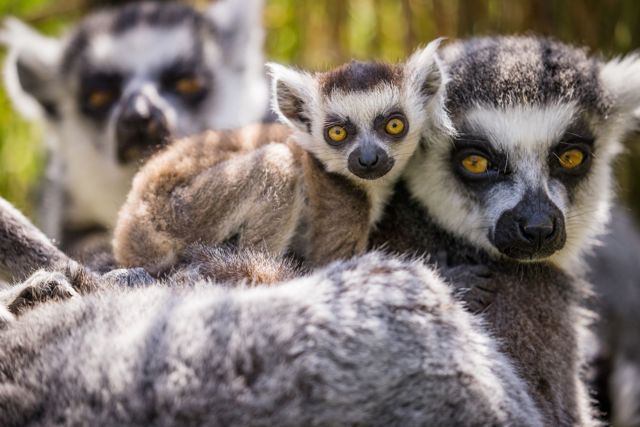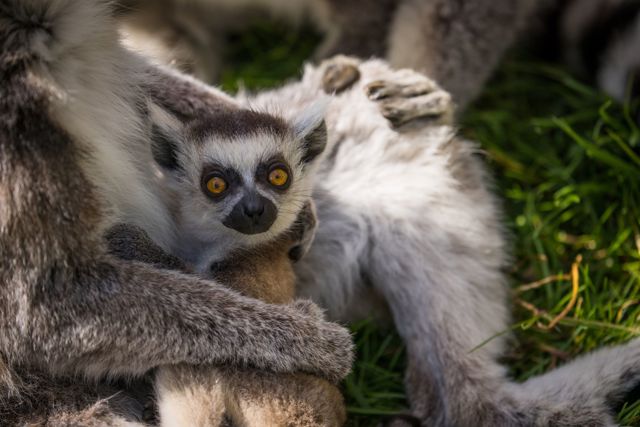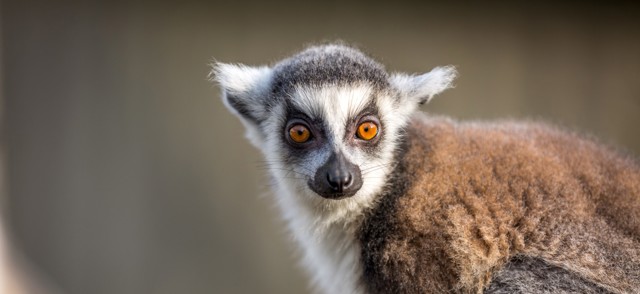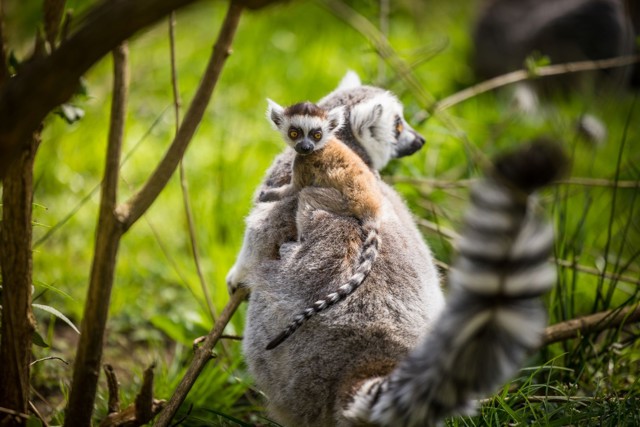
Overview
The ring-tailed lemur is the most iconic lemur species of Madagascar. They are easily identified by their distinctive black and white striped tail which gives them their name. They will spend more time on the ground than any other lemur species, moving on all fours with their tail in the air.
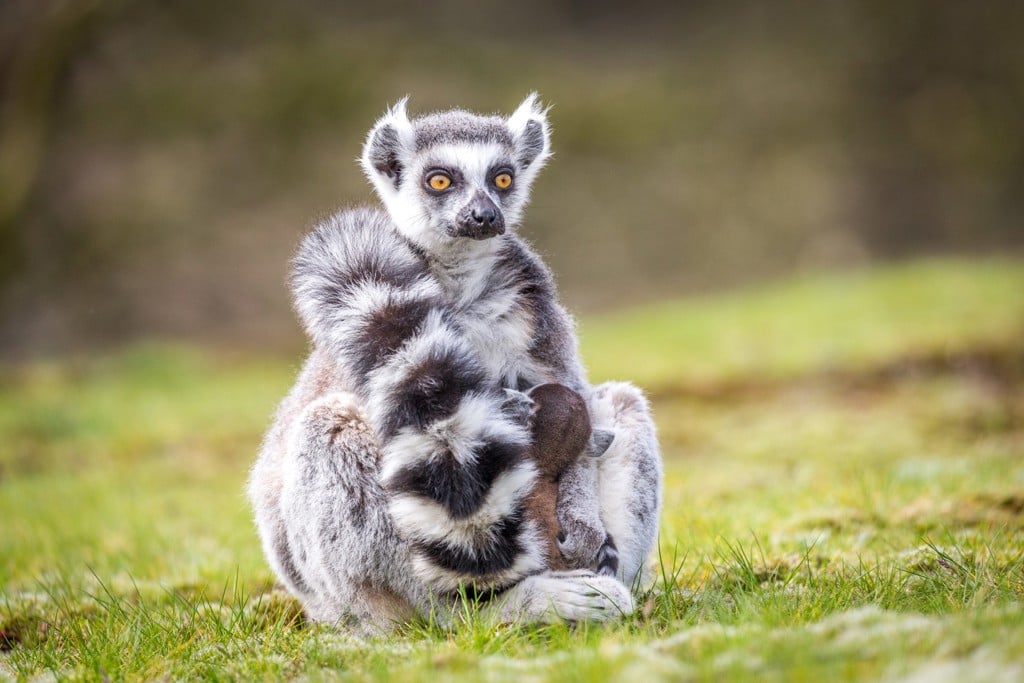
All about us
| Distribution: | Madagascar |
|---|---|
| Habitat: | Spiny forest, lowland gallery forest, dry scrub and rock canyons. |
| Height: | Body 38 to 45cm, tail 56 to 62cm |
| Weight: | 2 - 2.4kg |
| Lifespan: | In the wild 15- 16 years, in captivity 20 - 30 years |
| Threats: | Habitat loss and capture for the meat trade |
Scientific name: Lemur catta
There is a large group of ringtail lemurs here at Woburn living in the Land of the Lemurs enclosure in the Foot Safari, along with the red-bellied lemurs and black and white ruffed lemurs.
On a sunny day, you will find our ring-tailed lemurs sunbathing in a yoga-like position. They will often sit all in a row doing this for hours on end. They are the most active of our species when not sunbathing, they can be found jumping and running around the trees or walkway.

ring tailed lemur facts
- Physical features
- Diet
- Social structure & communication
- Husbandry and enrichment
- Threats & conservation
The male and female are similar in appearance and size. Their most prominent feature is the ringed back and white tail which gives them their name. The tail usually has thirteen black rings and ends in a black tip. Their bodies are mostly a greyish-brown colour, with white under parts. The head features large furred ears, and a white face with black patches around the eyes, and exposed black skin around a long snout.
They are agile climbers, with hands similar in structure to a human hand, including an opposable thumb, allowing them to grip when climbing and to hold objects. Their back feet feature a large modified big toe allowing them to grip with their hind feet just as easily. This species is the most terrestrial of the lemurs, spending significant time walking on all fours, tail held in the air.
They have a long thick tail, which although not prehensile, it is vital for balance when climbing and jumping, and is longer than their body length.
Lemurs have a much more developed sense of smell than other primates. They have an enlarged Jacobson’s organ, a sensory organ in their nose which allows them to read pheromones and other chemicals. Scent marking is an important behaviour for the ring-tailed lemur. Scent glands are located on pads by the wrists, and around the genitals. Males will use small spurs on the scent pads to scratch their scent into tree bark. They will also rub scent from these wrist glands onto their tails and then flick them at opponents in ‘stink-fights’.
The ring-tailed lemur’s diet varies over seasons, but consists mainly of leaves, flowers, fruit, sap and bark. They will feed on several species of plant and tree, but are commonly found feeding on the Kily tree. They will also occasionally eat insects and small vertebrae such as chameleons.
Like many lemur species they are known to occasionally eat soil, this is thought to help supplement sodium in the diet.
Ring-tailed lemurs are a social species, with larger group sizes than any other lemur. Group size is usually between 3 to 25 individuals, consisting of an equal amount of males and females, and their young. Females are dominant in this species, with an ‘alpha female’, but there are defined hierarchies between all group members, and within each sex group.
Although not particularly territorial they will have a home range with preferred areas, and will fight other overlapping groups for these preferred feeding grounds. Group confrontations usually involve the females facing off against the opposing group, using calling and barking, as well as occasionally fighting.
As their home range isn’t very large vocal communication is not very important for this species, however scent marking is a vital tool, used by both sexes to mark home ranges, and by males to fight for females. It is also used to fight to establish hierarchies and dominance.
Males and females both reach sexual maturity at around two and a half to three years of age. Females will give birth to one infant each year, or occasionally twins, which she will carry on her belly, and then later her back. Other females will assist with raring the infants, carrying them on their backs, and even occasionally allowing other females offspring to nurse. Mating is usually timed to ensure that births take place when food is most plentiful. Females will stay with the group they are born into, however males will leave on reaching maturity and move between groups every few years for the rest of their lives.
This species is diurnal, active during daylight hours, with bouts of sunning before and after foraging.
In the wild, lemurs would be found foraging for food up in the trees, climbing and jumping around. To allow them to mimic this natural behaviour, their enclosure is designed with large trees to traverse and ropes connecting different areas. The lemurs use these ropes and branches to manoeuvre around the enclosure well, promoting exercise, and demonstrating their natural climbing and jumping abilities when doing so.
Wild lemurs will spend most of their day foraging for food. To mimic this, and to keep our lemurs active, we spread their feeds throughout the enclosure, hiding food, placing it high up, making it hard to reach, and changing our feeding locations daily to keep them on their toes.
Lemurs are a small brained and less intelligent group of animals, so we have to make sure our enrichment isn’t too complicated, for example hiding food in puzzle feeders may prove too difficult for them to figure out.
Madagascar can have changing weather, from rain to severe heat and so the lemurs are adapted to both, but we give them a heated house all year round, with the option to venture into the cold, to mimic the temperature range in Madagascar.
The natural predators of ring-tailed lemurs are the Fossa and various raptors including the Madagascar harrier-hawk and Madagascar buzzard. They are also predated upon by domestic dogs.
The ring-tailed lemur is found in a several protected areas across its range, including six national parks, and several areas of sacred forest. Although it is thought to be at serious risk of long term extinction it is often found in areas of tourist activity, it is the most well known lemur species, and is found in many zoos around the world, giving the false impression that it is common. Wild numbers have dropped 20 - 25% in the last 24 years.
The main threat to lemurs is habitat loss, due to slash-and-burn agriculture, logging, and mining. This destroys habitats, and vital forest corridors which allow groups to move between locations. The bush and low level forest which ring-tailed lemurs are found in is also overgrazed by domestic animals, and they are often captured as pets. Almost 90% of the natural forest in Madagascar has been destroyed since human habitation of the island.
Although a large amount of conservation work is going on there is still a lot to do in terms of educating the people to the plight of all lemur species, and recovering the habitat before reintroduction can be a viable option. There are several conservation projects ongoing in Madagascar, including education projects, habitat repair, and eco-tourism. Some reintroductions of captive bred lemurs have been trialled in the past, but with mixed results.
This species is also part of an ESB, European studbook, meaning there is a keeper responsible for collecting all the data on births, deaths, and transfers for this species in Europe, and producing a studbook. They can also be asked for recommendations for breeding or transfers. Through their data collection they can assess how well a species is doing in captivity and if it needs to be managed more intensively as an EEP species.
The ring-tailed lemur is classified as Endangered on the IUCN Red List, and is listed on Appendix I of CITES, meaning the movement of this species is greatly controlled and restricted, trade in specimens of these species is permitted only in exceptional circumstances.
